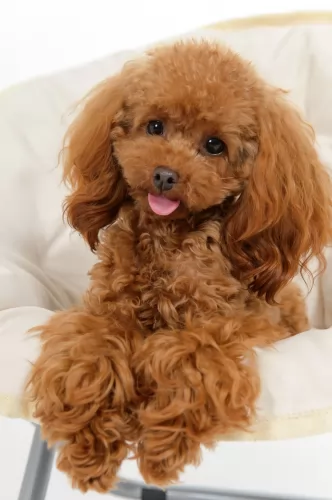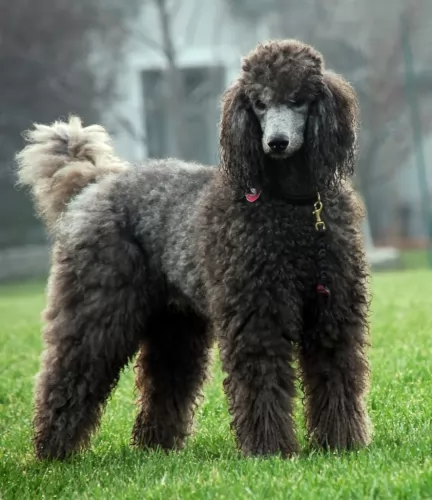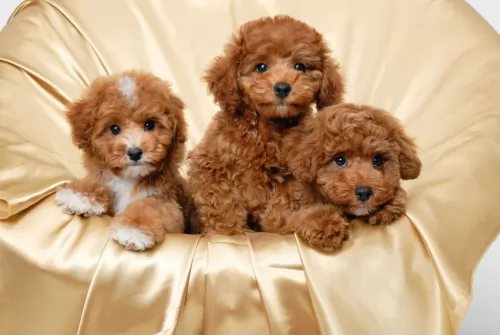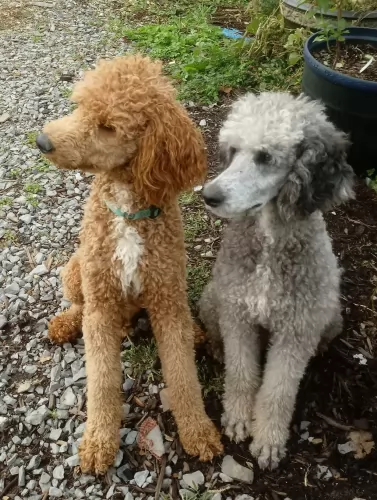 MyDogBreeds
MyDogBreedsAmerican Molossus is originated from United States but Poodle is originated from Germany. American Molossus may grow 21 cm / 9 inches higher than Poodle. American Molossus may weigh 14 kg / 31 pounds more than Poodle. Both American Molossus and Poodle has almost same life span. Both American Molossus and Poodle has same litter size. American Molossus requires Moderate maintenance. But Poodle requires High maintenance
Based on the massive dog of Mesopotamia in 5000 BC, the American Molossus is the same dog recreated in the United States by and for the lovers of these giant dogs. The ancient Molossus was fierce to look at, massive in size, courageous and loyal. He was undaunted by any animal and stood up to any man attempting to hurt his master. When Rome fell the descendants of today’s Molossus were scattered and attempts to revive the breed have created carious large dogs. The American Molossus is the first true recreation that hits the mark.
The original Molossus was one of the most primitive of dogs, one of the earliest dogs that men domesticated. Their initials duties were the guarding of herds and homes against all enemies. They were incredibly loyal to their one master and stayed with him and protected him. These dogs also ate carrion and served the villages by eliminating animal carcasses. They could handle any other hunting animals such as wolves and large cats. This dog, although extinct was the ancestor of all the Mastiff-type dogs of today. The Molossus is said to be the ancestor of the St. Bernard, English Mastiff, Greater Swiss Mountain Dog, Bernese Mountain Dog, Newfoundland, Great Dane, Great Pyrenees, Rottweiler, Rottweiler and the Neapolitan Mastiff. Now these breeds have become the ancestry of the American Molossus.
According to Marcus Curtis, the founder of the new Molossus, the nearest relative of the American Molossus is the Neapolitan Mastiff. The Hines Bulldog, German Rottweiler, American Bandogge, and South African Boerboel together with the Neapolitan Mastiff were used to form the American Molossus. The goal of the founder was to make a great family pet and protector. It was specifically bred to be courageous, loyal and protective.
 Poodles are said to be older breed which is developed to hunt waterfowl. They have their origin in Germany and developed as a breed in France. Many different arguements are there in their development. One of the arguement says that they are developed as a result of crossing European Water dogs. Egyptian and Roman histories have proof of Poodles in their drawings and statues. They were categorized into three types according to their size and are Miniature, Toy and Standard.
Poodles are said to be older breed which is developed to hunt waterfowl. They have their origin in Germany and developed as a breed in France. Many different arguements are there in their development. One of the arguement says that they are developed as a result of crossing European Water dogs. Egyptian and Roman histories have proof of Poodles in their drawings and statues. They were categorized into three types according to their size and are Miniature, Toy and Standard.
This is a giant, massive dog in every way and this recently developed standard makes that very clear. The Molossus should be heavy bones, muscular with a lot of loose skin and wrinkles of all kinds, everywhere. He is an intimidating presence, with a massive square head, broad shoulders, height and mass. No, the American Molossus is not athletic, but he certainly is intimidating.
His head is massive in comparison to his body and it must be square. He has extensive wrinkles and pendulous lips and dewlap. The face is all folds of skin and wrinkles. Deep set eyes, drooping upper lids and lower lids as well as an intimidating expression. His brow is well developed with a marked frontal furrow. The nose is large, and the muzzle is about a third of the length of its head. It is short and broad. Everything about the head must be square. It’s neck and body are powerful and muscular. The chest is deep, wide and barrel like. The back is also powerful and muscular. The front legs are heavy and muscular while the hind legs are broad, strong, powerful and wide-stance. Do not remove the front dew claws. His tail is thick and wide then gradually tapers at the tip.
 Poodles today lives a luxury life but actually they are bred to do work. They are well known for their intelligence and are really water retriever. This is because they show their energy in hunting waterfowl. The name Poodle is said to got from German word "Pudel" which means "splash in the water".
Poodles today lives a luxury life but actually they are bred to do work. They are well known for their intelligence and are really water retriever. This is because they show their energy in hunting waterfowl. The name Poodle is said to got from German word "Pudel" which means "splash in the water".
Their hair is trimmed in such a way to make them swim easily. Hair is not trimmed in the joints and organs such that to protect them from cold water. Poodles are well known for their wonderful personality and intelligence. Also they are very obedient and a good companion. They won't be happy if left alone for a long time. Poodles are interested in playing games with people. They perform very well if given a proper training. Good manners should be taught to them as they remember all things they have learned.
The American Molossus is an intimidating massive giant bred for protection and guard duty. He is incredibly loyal to his family and courageous in his protection of them. They are guard dogs, not attack dogs. Their simple appearance is usually enough to frighten off anyone intending harm on their families. He is in reality a loving giant. He is intelligent and stable with a strong desire to please his owner. He is a calm yet vigilant presence in the home.
Because the Molossus is so large, it is recommended that the puppy be socialized and trained professionally. It takes a strong owner to handle this breed. They need to know the rules and have the rules consistently applied. The owner must be the pack leader.
 They are good companions and usually likes to spend time with children. Even they are children friendly it is strongly recommended not to leave children alone with them.
They are good companions and usually likes to spend time with children. Even they are children friendly it is strongly recommended not to leave children alone with them.
Poodles are specialist in hunting water birds. They are good in swimming since they are covered with fur water will not easily get into their ears. They are well known for their intelligence like humans.
They are well suited for apartment living but won't be happy if left alone. They will tolerate hot weather better when compared with cold.
They are quick learners and learn good and bad things very quickly. Once they learn, they won't forget it up. Since poodles are so intelligent they are very easy to train.
Like all Mastiffs the American Molossus faces a variety of potential illnesses, some brought on by its size, some not.
This could easily be a function of its massive size. It is a degenerative disease and can cause the dog to become lame. In many cases the vertebrae can fuse, or severe pain can result. This is mostly seen in older members of the breed.
Male Molossus can contract this inherited metabolic disease primarily. It can be life threatening and very serious as it affects the kidney and the bladder.
This is essentially Cervical Vertebral Instability (CVI) and is caused by the pressure of the nerves in the neck and cervical spinal cord. This compression can cause deformity, pain and abnormal stance/gait. IT has been attributed to the nutrition needs and rapid growth of the Mastiff breeds.
Like all giant Mastiff breeds the Molossus can have skin issues from the wrinkles, dysplasia in the joints which we will address below.
 Poodles have more chances for getting eye diseases such as Progressive retinal atrophy and cataracts. Cancer is also seen in them and there are chances of skin problems such as allergies and tumors.
Poodles have more chances for getting eye diseases such as Progressive retinal atrophy and cataracts. Cancer is also seen in them and there are chances of skin problems such as allergies and tumors.
Usually poodles don't shed at all. Excessive shedding is the smptom of allergies in them. When they get other problems shedding accompanies with it. Even an infection may cause hairfall. Ringworm infections and pests should be controlled using appropriate medicines.
Remembering that this is a very, very large dog you need to be careful about nutrition and how fast your puppy will grow. American Molossus puppies need four meals a day until 12 weeks old. Then until they are 6 months old feed then 3 times a day. Finally, from 6-month-old puppy to adult – feed them twice in 24 hours.
At one year either feed them once or two small meals.
Many people feed their Molossus eggs, vegetables, fruit, and cottage cheese as ten 5 of the total for the day but avoid other table foods. The Molossus can become very picky about what he eats if you feed him too many table scraps.
In addition to the health problems listed above, the American Molossus is also susceptible to: Ditichiasis – Eyelashes that are in the margin of the eyelids and can cause eye irritation. May require surgery to correct.
Could cause blindness if not removed. Ectropian/Entropion: Eversion and inversion of eyelids which cause ocular irritation.
This is a degenerative disease which causes the dog to go blind. It is a disease the affects the retinal visual cells, first causing night blindness then day blindness. A DNA test is available for detecting PRA in all Mastiff breeds.
Common in large breeds and especially in giant breeds like the Molossus. Multiple forms and causes but all can cause pain and lameness.
Do to wrinkles and loose skin – check often for moisture and infections.
The is a problem based on a variety of possible causes. It happens when the puppy is between 6-16 months of age. Lameness occurs over time in one limb or in all. It can be intermittent and might be caused by diet, genetics, stress, autoimmune or metabolic issues or infection.
This issue is developmental as the dog’s toes turn either inward or outward, then as the condition advances the dog suffers fever, pain in all joints, lethargy and the inability to stand. This happens when the dog consumes too many calories for his activity level in the development times.
The American Molossus is not a couch potato. He needs to be walked at least twice a day and loves to play fetch. He will be greatly benefited by obedience training. Do not overdo it with exercise but make sure they don’t just lay around.
 Usually puppy eats more food than an adult dog. This is because they need more food to support growth. Actully puppies need two to four times more food than adult. Puppies should eat in such a way that their ribs should not be seen and waist must be visible.
Usually puppy eats more food than an adult dog. This is because they need more food to support growth. Actully puppies need two to four times more food than adult. Puppies should eat in such a way that their ribs should not be seen and waist must be visible.
Poodles can be fed with proteinous food, healthy grains, vegetables and fruits. They love to eat organs such as liver, kidney, brain and chicken breast, turkey and fish. Vegetables such as baby carrots, spinach and peas can be given to them. Make them to eat fruits like raspberries, banana and melon.
Dry kibble is not good for their teeth. Even some premium quality foods are not good for their health. Pig's ears are not safe to chew for them. Vaccinations should be made at the right time.
Exercises play an important role in their health and even extend their life. Poodles should be made to walk regularly. Exercising must be done to a particular level and they should not be over exercised.